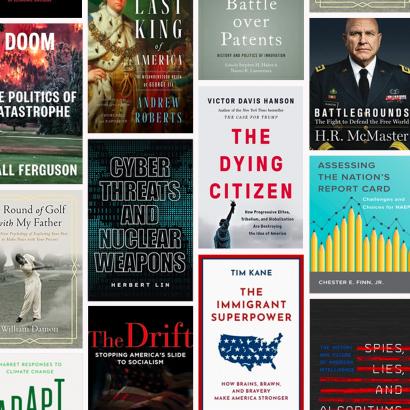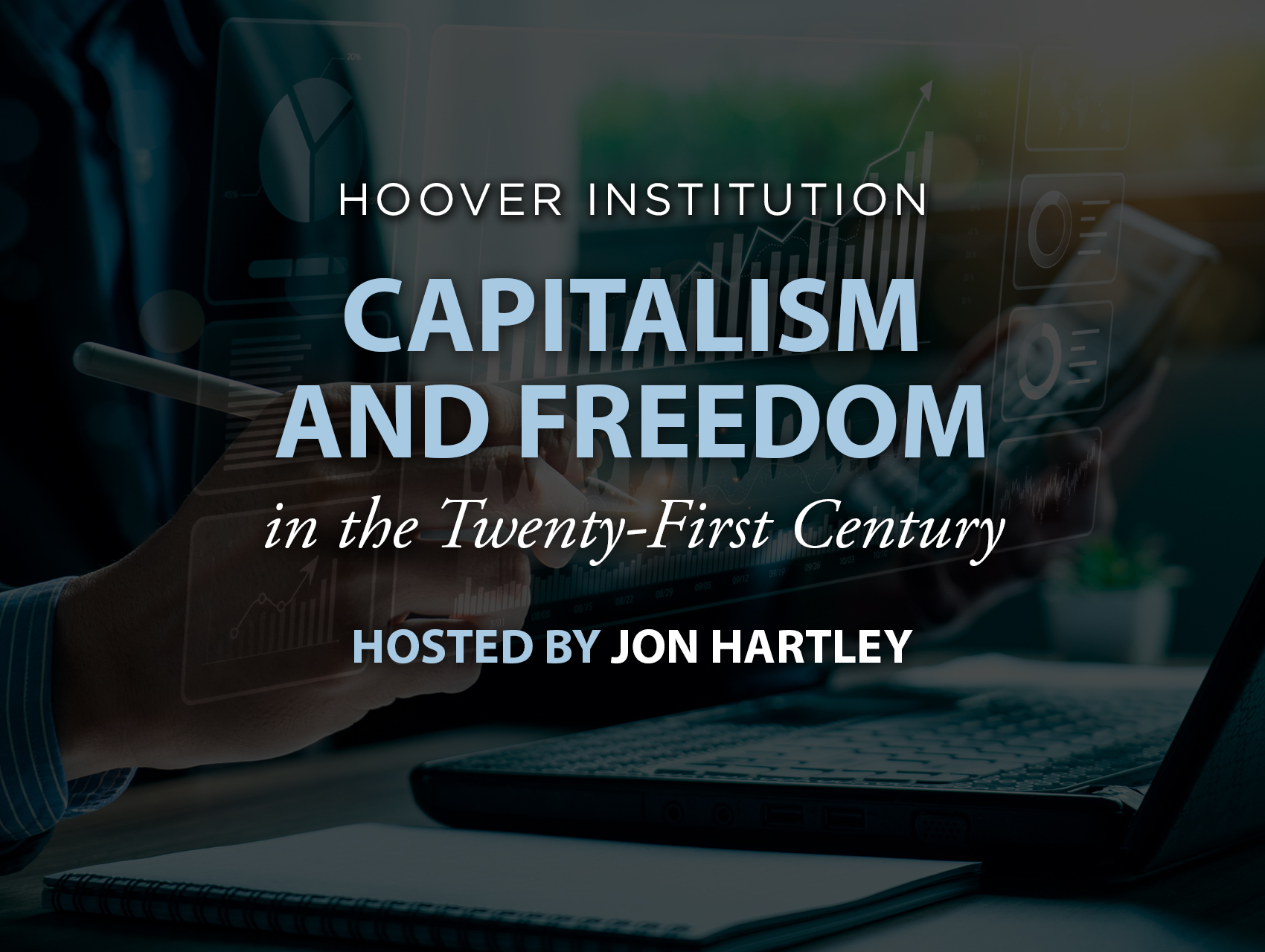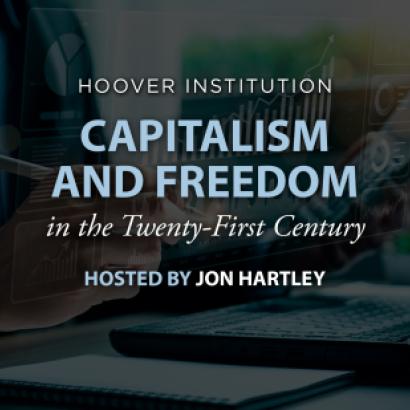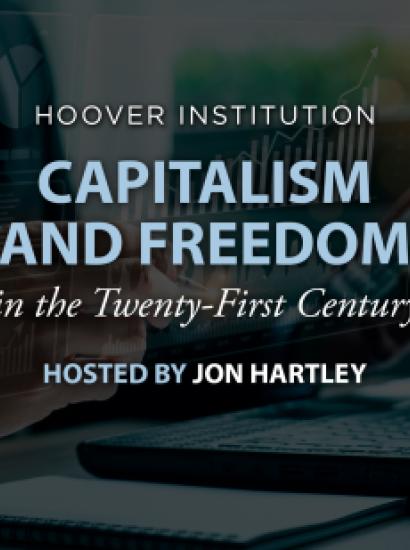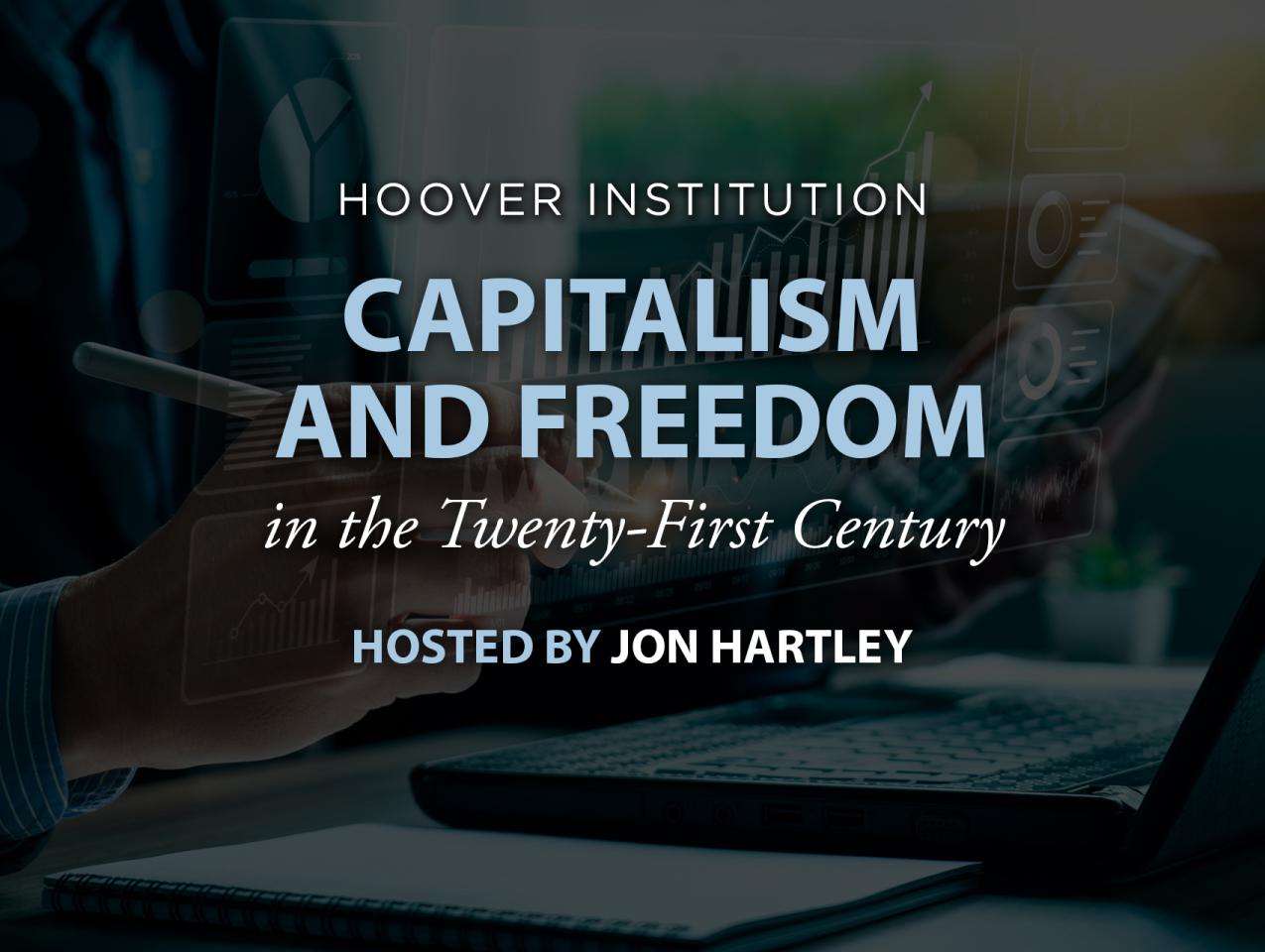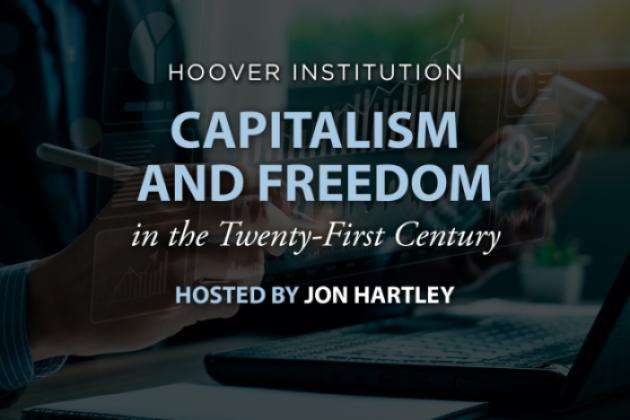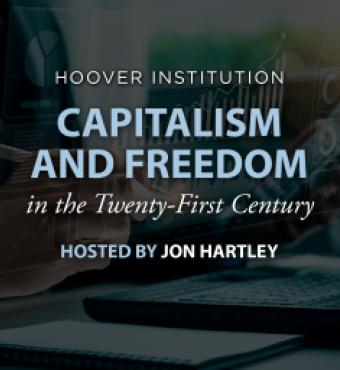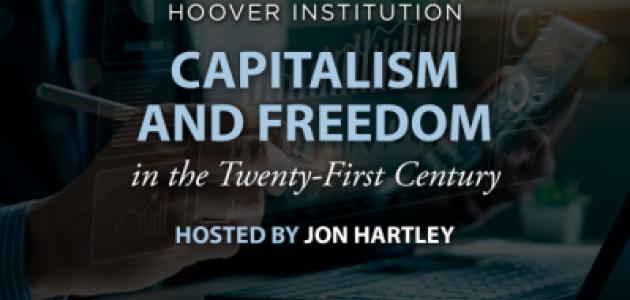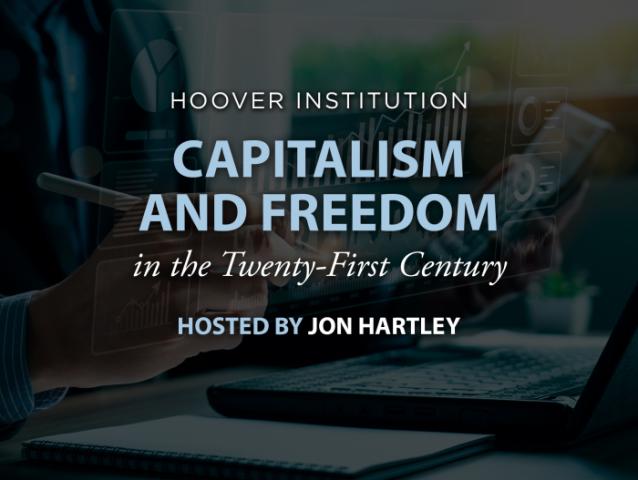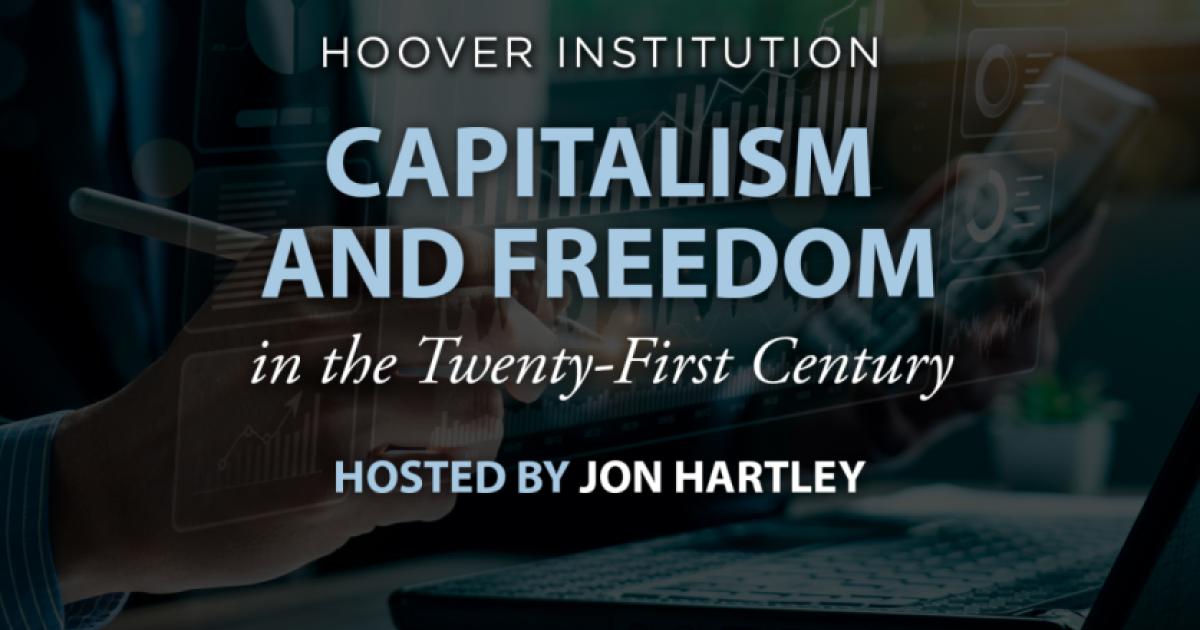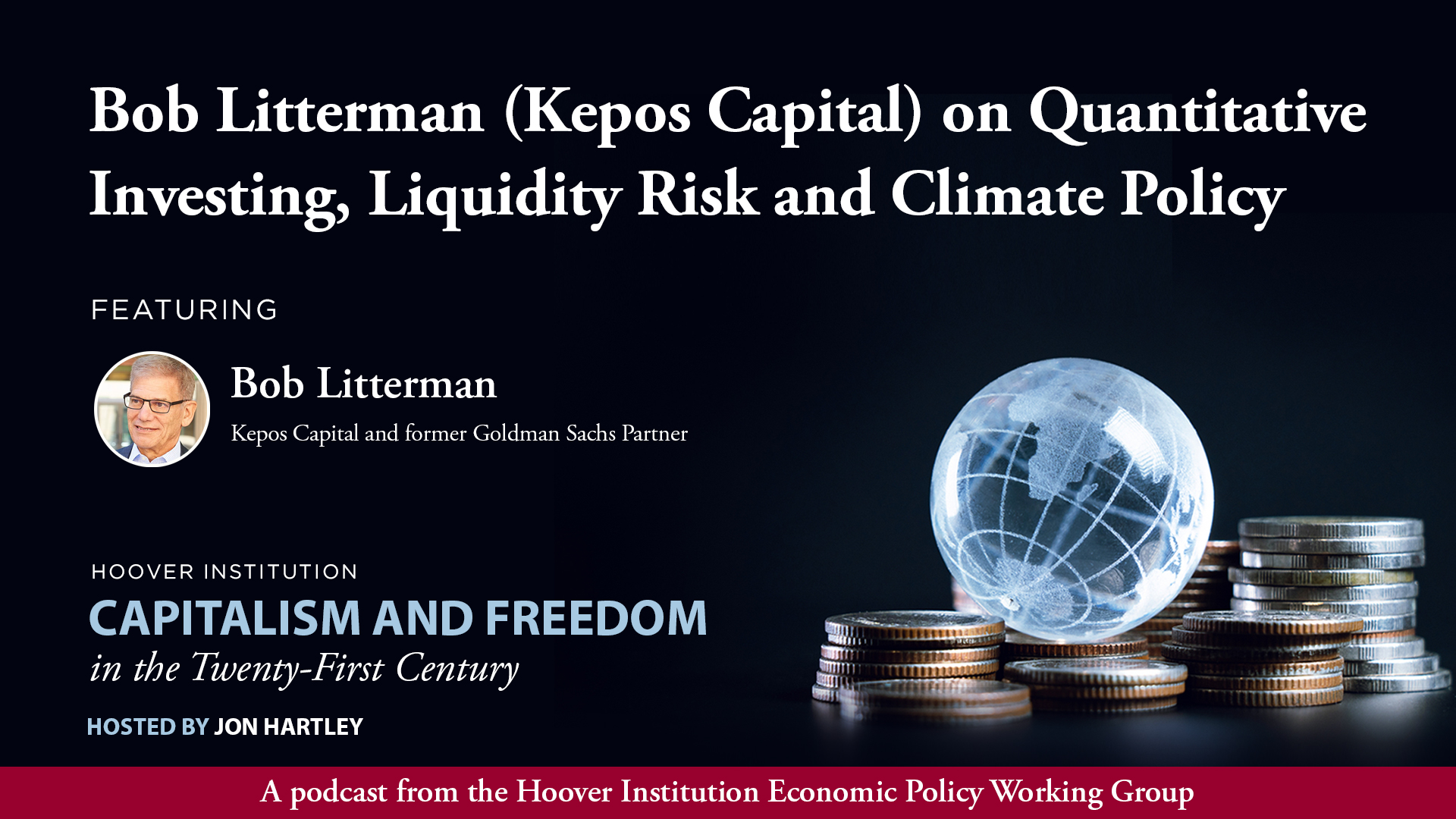- Economics
- Answering Challenges to Advanced Economies
Jon Hartley and financial leader Bob Litterman explore the history of the development of quantitative finance at Goldman Sachs, including his seminal work with Fischer Black. They explore the carry trade liquidity crisis of August 2024, comparing it to the quant meltdown of 2007. They also discuss the case for quantitative investing and its ability to ride out risky environments, a risk management approach to climate policy, Bob’s E-Z climate carbon pricing model, and Bob’s advocacy for carbon taxes.
Recorded on August 9, 2024.
Jon Hartley: This is the Capitalism and Freedom in the 21st Century podcast, an official podcast of the Hoover Institution Economic Policy working group where we talk about economics, markets and public policy.
I'm Jon Hartley, your host. Today my guest is Bob Litterman, who is a founding partner at Kepos Capital where he's also chairman of the risk committee. Prior to Kepos Capital, Bob spent 23 years at Goldman Sachs where he was head of the Quantitative Resources group in Goldman Sachs Asset Management for eleven years starting in 1998.
Prior to that position, Bob headed the firm-wide risk department from 1994 to 1998. And prior to that, he was the co-head of the model development group in the research department of the Goldman Sachs Fixed Income Division where Bob developed the famous Black-Litterman model of portfolio optimization together with Fisher Black in 1990.
Prior to that, Bob did his PhD in economics at the University of Minnesota under the supervision of Tom Sargent, graduating in 1990. Bob is also a prominent climate policy expert and advocate of carbon taxes. Bob developed the EZ climate-carbon pricing model with Columbia's Kent Daniel and Gernot Wagner and led the climate-related market risk subcommittee of the CFTC.
Thank you so much for joining us today, Bob.
Bob Litterman: It's my pleasure. Thank you, Jon.
Jon Hartley: Bob, I want to first sort of get into your background here. You grew up in Phoenix, Arizona. How did you first get into economics and decide you want to do a PhD? Was it during your undergraduate studies at Stanford?
Were there any particular influences that stood out?
Bob Litterman: No, actually my interest in economics was really a bit of a course correction that came later. My undergraduate degree at Stanford was in human biology, which by the way was itself a bit of a course correction because I started as a physics major.
But in the spring of 1970, the Vietnam War protests reached a crescendo and that was my freshman year at Stanford and the entire student body kind of went on strike that spring and I thought I needed some more flexibility in my program. So I dropped out of physics and I joined about a third of my freshman class in this new major and in an interdisciplinary program called human biology, which to this day is still one of the most popular majors at Stanford.
But my original career choice was actually journalism, which was an interest that I began in high school, following in the footsteps of my older brother. And I've always appreciated the basic writing skills that I honed as a young journalist. My first real job after spending four years at the Stanford Daily was as a general assignment reporter for the San Diego Union.
But after only three months on the job, they moved me from San Diego County out to El Centro in Imperial County, which is kind of rural Central Valley, California, best known for something called the Salton Sea, which was a bit of a man-made disaster. But anyway, I was reporting from the El Centro office, and in fact, I was the El Centro office, and I had to fill a page every day of whatever was going on in the valley.
And that was kind of fun. But like I said, it was a little bit out in the boonies. There were no computers in the Central Valley of California at that time. And more important, it just wasn't a very attractive location for a single Jewish male looking to meet members of the opposite sex.
So I thought about going back to graduate school, and I guess I assumed that economics training would help me become a business writer. But it turned out I went to the University of California, San Diego, which had a very mathematical program. And when my first micro course, I had a textbook theory of value by Debreu, it's kind of a very mathematical text, it became clear that it wasn't really gonna help me as a business writer, but I enjoyed the math, and I had unlimited access to computer time there.
And I met my wife Mary there. So it was all good.
Jon Hartley: Wonderful. It's funny, you wouldn't be the only economist out there to go from physics to economics. Hoover's very own John Cochrane was in a physics PhD program before moving to economics and many others. A lot of the same mathematical tools like solving partial differential equations can be very useful in economic theory as well.
I want to get a little more into what graduate school. What was graduate school like for you? I think you graduated from the University of Minnesota. You were a Tom Sargent student, if that's correct? Minnesota is a very famous and distinctive place for macroeconomics, and not to mention you were there when the rational expectations revolution was going on, being led by luminaries like Sargent, Lucas, Prescott, who revolutionized macroeconomic theory and modeling. I think you might have even overlapped, let's say, Lars Hansen as students and I'm sure many others.
What was that time like, doing a PhD in the late 1970s?
Bob Litterman: Yeah I mean, it was incredible. You have to appreciate that. I ended up at Minnesota because I followed my wife, who was my girlfriend at the time, from San Diego to Minnesota because that's where she was from, and she was going back there and going to.
So after a year, she transferred back to Minnesota. And I went out there during the summer, I guess it was in August, and just decided kind of spur the moment, to see if I could get into the Minnesota program. So I went to the graduate department and said, “any chance I could start here in a few weeks?”
And they were very nice. In fact, they said, sure, we don't have any money for you, but they got me a job. They actually had some contacts at the computer center. And so I went and applied for a job there, which, to be honest, I wasn't at all qualified for, but I became a consultant.
Consultant, and those were the days when computer centers were offsite and you'd go there with cards. And I just sat at a desk and answered questions and supported some computer packages for statistical analysis, all of which were terrific skills to put together. But anyway, yeah, the department at Minnesota that I got into was unbelievable.
And of course, at the time, I didn't appreciate that. So I showed up and, yeah, Sargent was there, Sims was there, I worked closely with them. You mentioned Lars Hansen. I mean, he was one year ahead of me. And you can imagine I didn't really have the background to appreciate what was going on around me.
I thought when I met Lars, wow, this guy's amazingly smart. But I just thought, well, if they're this smart at Minnesota, can you imagine what they must be like at Harvard and Stanford and all? And of course, that wasn't the case. Lars was the best economist of our generation.
And so I had kind of a warped view. In fact, I ended up working with both Sargent and Sims. But I didn't think I was going to be an academic even from the beginning I was there, I thought, you know, I'll pick up some useful tools and especially the computer tools and, you know, forecasting tools and a lot of things.
Anyway, after a few years and I had a very nice dissertation on forecasting with Bayesian vector autoregressions, Tom asked me, where do you want to teach? I said I'm planning to go into business. And he was like, you can't do that. I didn't appreciate how he would react, but of course, he made a good argument.
He said, you can always go from academia to business, but if you don't go on the market and start in academia, you can never do it later. And so he convinced me to go on the market. And to be honest, Lars had just gone on the market a year before from Minnesota and ended up at Carnegie Mellon.
But a year later there was a feeling that, boy, these Minnesota students were really good. And so I kind of rode that wave and got a lot of good offers, including one from MIT. So I ended up going to MIT. But even after four years at Minnesota, I just thought these rational expectations thing is kind of interesting, almost religion here.
And I assume that that was sort of freshwater economics at saltwater economics at Harvard and Yale and so on and would have their own ideas. But when I got out, what I discovered is, no, actually, Minnesota was kind of special. And the folks at MIT and Harvard were very interested in learning about the tools and techniques and so on that we were developing, the rational expectations tools.
So it's really when I got to MIT, I realized, wow, Minnesota was incredibly special, yeah.
Jon Hartley: Absolutely, well, yeah, it's absolutely right. I'd imagine that all the RBC machinery started there in those freshwater schools, places like Chicago, Minnesota. And that was very much a response to the great inflation era and the inability of traditional IS-LM Keynesian models to really be able to explain, I guess you could call it stagflation, high unemployment, and high inflation at the same time.
And just this sort of general criticism or things like the Lucas critique that really there was a need for micro models or a model that has individual agents in it. And then over time, I guess, through the 80s and the 90s, places like Harvard, MIT, and scholars there developed the various sort of new Keynesian models that are based on those DSGE models and include things like sticky wages, sticky prices, and I'm sure it creates more room for policy for central banks and so forth.
I'm curious, I mean, what was that time at MIT like? And I'm curious, I also want to get into your time at Goldman Sachs, how you got your first job at Goldman Sachs in the Goldman Sachs fixed income division research department, how you met Fischer Black. I mean, really one of the great financial economists of the 20th century.
And I'm curious, how did the famous Black-Litterman model of portfolio optimization came about?
Bob Litterman: Sure. Well, interestingly, I first met Fischer when I was in Minnesota as a graduate student. And I was working at the Federal Reserve Bank there as a research assistant for Tom.
And Fischer more or less called the folks at Minnesota up and said, can I come give a seminar on rational expectations? And so they said, sure. And he came actually to the Fed. And I remember it well, it was a very bizarre seminar. And later I learned that this was very typical of Fischer.
But you can imagine, I was just a graduate student. And he shows up and starts talking about some Robinson Crusoe economy and put some things on the board. And after about ten minutes, I think it was Tom who said, Fischer, can you talk a little bit more about the production function in this economy?
And Fisher was like, hmm, long pause, which turns out was typical of Fischer. And he says, yeah, that's a very good question. And then he sits down, pulls out a notebook, and starts writing. And basically, that was the end of the seminar. At that point, it just became a back-and-forth.
But I thought, wow, that is very strange. Well, then later I accepted a job at MIT, and MIT was also a pretty incredible place. I mean, Paul Samuelson was there and he used to hold- Stan Fischer, and- Stan Fischer was there, Larry Summers was an assistant professor along with me.
We had offices next to each other and an awful lot of really good graduate students. And, you know, but Fischer was there in the business school and so I got to interact with him again there. And after two years at MIT, I decided that really, academia wasn't for me.
I enjoyed the research. I really enjoyed my time at the Minneapolis Fed when I was there working as a graduate student. And so I called up Tom and said, any chance I could come back to Minnesota? And the next day I got a call from the head of the research department at the Minneapolis fed, Art Rolnick, saying, Bob, I hear you want to come back.
When do you want to start? And so I went back to the Minneapolis Fed for about five years. And I was kind of in charge of forecasting, and I was really quite happy working for the president of the Minneapolis Fed, Gerry Corrigan, who was kind of Volcker's right-hand man at the time.
So it was very interesting times.
Jon Hartley: Later [Gerry] became the president of the New York Fed.
Bob Litterman: Later [Gerry] became the president of New York Fed. And then after that, came to Goldman Sachs.
Jon Hartley: Right, right.
Bob Litterman: Yes, I worked with him there. So Gerry and I overlap quite a bit.
But at some point, I got a call from a headhunter. I didn't even know what a headhunter was. And you can imagine my fed compensation at that time. I think it was $35,000. Quite a bump up from MIT, by the way, where I think when I left, I was making $20,000.
But anyway, Goldman Sachs offered me a base salary of $200,000. And they kind of said there was a bonus. But what I didn't realize was that the bonus was the bigger part of the total compensation. And. But anyway, it was kind of an offer I couldn't refuse. Mary, I moved to New York, and I started at Goldman in 1986.
Well, Fisher Black was at Goldman. He was there.
Jon Hartley: Was he part of hiring you there?
Bob Litterman: He was indeed. And it's funny. If it was up to Fischer, I don't think I would have gotten the job. He was one of the first Ph.D.s hired on Wall Street.
They called him a rocket scientist, I think. And the position he took, they kind of said, Fischer, what do you wanna do? And he said, well, there's this arbitrage out there between the S&P futures and the value line futures. And I've been talking about it for years at MIT, but it's still there, so let's try and take advantage of it.
And sure enough, there was a research assistant there who programmed up the trades that you'd have to do, and they did them. And sure enough, made about $20 million for Goldman Sachs, killed the value line index, and it was considered a big success. So I was maybe the next round of PhDs that they hired.
And, well, I was interviewed by Fischer, even though he was in the [Goldman Sachs] Equities Division, and I was going to come into the Fixed Income division, but he, he was the academic there. And so I came in for the interview, and he said to me, Bob, you're an econometrician, right?
I said, yeah, I'm an econometrician. I thought, this is great. He says, so what makes you think an econometrician can add any value on Wall Street? I was like, I don't know, maybe we can estimate some parameters or something. He was very skeptical. And so then he asked me, he says, so tell me, what's the difference between a first moment and a second moment?
And I was like, well, the first moment is like a mean, and the second moment is like a variance. I had no idea what he was asking, but he was a very practical guy, and he had this idea that expected returns, which you can estimate by taking the mean return, are basically unknowable and inestimable.
You can't really get a lot of information about it. And whereas variances, if you chop the data finely enough, you can get more and more information. So he felt like you might as well treat those as observable. Well, I flunked that question, and I don't know if Fischer would have hired me if that was coming into equity research, but it was Fixed Income research.
I got the job, and then it wasn't too many years later, maybe three years after I joined Goldman. And I had a great time there. It was a time when markets weren't as efficient as they are today. And if you came in with some computer skills, there were just a lot of things that had never been done.
Estimating factor models, fitting yield curves, and valuing embedded options. We were doing all kinds of fun things. And at some point, my boss said to me, our clients in Japan, so this is in the late 80s, and the Japanese stock market had gone crazy, and they had all this wealth that they wanted to invest globally in fixed income markets.
And so my boss said, Bob, we need an asset allocation model for our Japanese clients, but I don't want to have a separate model and Tokyo and a different one in New York. So why don't you build us an asset allocation model that we can use everywhere? And so he said, and why don't you talk to Fischer about it?
So I went to Fischer. I'd never used or played with an asset allocation model. I said, so what are these models? What do you suggest, Fischer? And he said well, I always start simple, and then if it doesn't work we can get more complicated. But the simplest approach here is mean-variance optimization.
Jon Hartley: Just like Markowitz mean-variance optimization starting from here. And I think it's solving the problem that expected returns aren't really a stable quantity.
Bob Litterman: Right, right. So I looked up the mean-variance model. I'd never, like I said, never played with it, programmed it up. It was pretty simple.
And I was only using bonds. So I had, I think, 20 bond markets and then 19 currencies to play with. And so we put that into a covariance matrix. Well, you can imagine it was nearly singular with all the high correlations among those currencies and bonds. And so I then put in the expected returns that came from Goldman Sachs's economists.
It was a nice place to be because there were plenty of forecasts around, so I didn't have to worry about coming up with the forecast. Well, you can imagine without any constraints, the model went crazy and long, 400% here and short 300% there and so on. And so I went back to Fischer.
Well, and by the way, if you then change those expected returns a little bit, maybe change the forecasted yield six months out by five basis points, the whole thing would change completely.
Jon Hartley: Very unstable. So I guess just to give our listeners a bit of sort of a history of some of these models and just really how important your contributions with Fischer Black are, and those, I really can't overstate how seminal these contributions have been.
So Fischer Black came up with Black-Scholes model in the 70s and that became a widespread options pricing model. Black-Litterman model is based on Markowitz’s mean-variance approach, where. You're trying to maximize your expected returns, so that's taking the percentage returns or just percentage changes on prices.
And we're trying to maximize returns subject to some level of volatility or standard deviation of those returns. And the problem with the original sort of Markowitz mean-variance optimization, which came in the 1960s. And Harry Markowitz, who's now passed, famously came up with, I think, maybe in the 50s or 60s.
But the problem, as you've illustrated, is that it's not very practically useful to investors. Because the recommended weights will change very quickly depending on how you, say, update or change your expected returns. And then, many investors have various constraints. They can't short, or they can't use derivatives or things like that.
How do you make a model useful to those sorts of investors? That's exactly what Black-Litterman does, and it's been used certainly by quantitative investors and many others very pervasively. And so the success of that approach can't be overstated, and I think, tragically it's also worth pointing out, too Fischer Black passed away in the mid-1990s.
That was life cut short, very young, from cancer, and it's amazing I've heard stories from my time at Goldman Sachs that Fischer was a very kind of eccentric guy. He was one of the first people to get computers and sort of would be in his office and close his blinds, all sorts of things, but like a true genius in many respects.
And the work that both yourselves have done and contributed to and being pioneers in financial economics really can't be overstated. I wonder whether maybe Bob Rubin was part of that hiring. I mean, Bob Rubin, who later became Secretary of the Treasury, he sort of made his name in that fixed-income division.
And there was a lot going on at that time in terms of PhDs, adding value to financial economics. You think about those that aren't familiar with the book, When Genius Failed, which talks a lot about Long Term Capital Management. That firm was founded by Salomon Brothers alumni. They were doing a lot of fixed-income arbitrage, they famously blew up in the late 1990s.
They also had Myron Scholes involved with their firm, along with Bob Merton. Whereas yourself and Fischer Black were at Goldman Sachs. Goldman Sachs survived that era of the late 1990s that featured the Asian financial crisis. Which sort of blew out some spreads like the on-and-off Treasury trade, that those fixed income arbitrages kinda blew up temporarily and firms like LTCM were taking a lot of risk.
I sort of want to move on to your later Goldman years, investing in GSAM and using tools in that group, which I worked in after your time, after you had left in 2009, I actually joined that group in 2011. You were really one of the great pioneers of quantitative investing.
And on top of developing Black-Litterman portfolio optimization model, you were really one of the first to really build and run systematic quantitative portfolios based on factors and ideas like momentum and value. The idea in the case of momentum, if a stock's gone up, say a lot over the past twelve months, that it's going to continue to go up over the next few months or so.
Value investing being sort of almost diametrically opposite of that, but somewhat different. The idea that companies that have high book-to-market ratios or good fundamentals should outperform in the future. And you've done, I think, a lot of this in the macro space as well, so thinking about time series momentum and various macro assets.
It's worth noting that in this era, you moved to Goldman Sachs Asset Management in 1998. It's worth noting that there are a lot of economics PhDs working in those quant groups as well within GSAM, Goldman Sachs Asset Management. A good number of Eugene Fama students in that era, you had folks like Cliff Asness, who left to start AQR, Mark Carhart, these are all University of Chicago economics PhD students, students of Eugene Fama. You also co-authored with many of the people in the Goldman quant group, the investment classic modern investment management equilibrium approach, which talks about things like Black-Litterman and related concepts. And you really helped build that quant business at Goldman, at its peak in the mid two thousands, became one of the largest quantitative hedge funds in the world.
And since leaving GSAM, you also co-founded Kepos Capital, which is a quantitative asset management firm that you run along with Mark Carhart, many others from the old GSAM team. The firm now manages over $2 billion, again, each serve as chair of the risk committee. What do you think is the best case for systematic quantitative investing today?
So, using factors, thinking about things in expected returns and volatilities, using portfolio optimization tools like Black-Litterman, I mean, what is the best case for that approach today? As opposed to, say, a more discretionary or concentrated types of investing that many others still use today.
Bob Litterman: Yeah, well, your brief history there is very accurate.
And you're right that when Fischer and I first started with that mean-variance model, it was incredibly badly behaved. And I remember going to Fischer and saying to him, I don't know how people can use this. And he said, yeah, no, they put constraints on everything, maximums and minimums.
And I said, well, then there's no value added, and he said, yeah, no, there's no value added. And he was right, and so he suggested, why don't we put this equilibrium in there? It was a very academic-sounding idea, but it turned out to work really well. And so we started trying to market the model, actually, at first.
And we discovered that there weren't too many people out there, first of all, who were quants, and then secondly, who actually used a model. There was a little bit of quant marketing, but not a lot of really depending on models, because people didn't trust him and they didn't work that well.
But I was very lucky at Goldman Sachs to come in and have Fischer there and develop that model with him. And we first started using it internally to understand that the risks that Goldman was taking. And then we started using it at Goldman Sachs Asset Management to build portfolios.
In fact, Cliff Asness, who was at Goldman Sachs Asset Management before I arrived, developed this quantitative team and started using Black Litterman. And he also used a computer program that I had a hand in creating. Called RATS (regression analysis of time series). And he was incredibly successful the first year of the hedge fund he ran at GSAM.
I think it had like 80 or 90% returns. And as a young quant I was like, wow, that's pretty good.
Jon Hartley: Was that Global Alpha?
Bob Litterman: Yeah, that was, Global Alpha it was called. And then Cliff decided he was going to leave and form his own firm, which obviously AQR became very successful.
And I was lucky that Goldman asked me to come in and take over the business that he was running. And that's when I saw these incredible returns and the use of Black Litterman and RATS. And then Mark Carhart and Ray Iwanowski were there. And so it was a great time.
In fact, very lucky for me, the timing, because that was right before LTCM blew up. And as you may know, the broker-dealer side of Goldman Sachs had a lot of the same trades on that LTCM had. So having left the risk management position right before all of that happened was good timing.
And then arriving in GSAM and heading this quantitative group when markets were very disrupted also created an awful lot of opportunities. Volatility, which not a lot of people thought of as an asset class, but we did was trading long-term. Volatility was trading at unbelievable levels, and you'd have to think that the market would be disrupted and three times normal volatility for the next five years to make these prices make sense.
So we decided, all right, we can do this. Everyone was afraid of touching it because it had just gone up and up and up as LTCM and others were covering their positions and they had shorted the volatility and now it was just going crazy. We came in and we started selling volatility at the peak and it turned out to be a very, very profitable trade.
So that was lucky. And then the markets weren't as efficient in those days. And so you're right, we started investing in factors and it seemed like this just was almost like magic. You could create these factors that would work and be uncorrelated with the market and you put together a bunch of these factors that are uncorrelated and you can get very, very good returns.
And there are a couple of lessons here that we discovered. One of them is that you have to worry about crowded trades, and that's kind of obvious.
Jon Hartley: And I'm going to get to that in just one second, I mean, before we get to the quant crisis of 2007.
Bob Litterman: Yeah, sure.
Jon Hartley: It’s so worth highlighting just how successful the Goldman Sachs Asset Management quant business was during the 2000s. So we were talking about the late 90s, LTCM blowing up, you coming into GSAM in 1998. There was a stretch from roughly that 90s period to really 2006, 2007 or so, where Goldman Sachs Asset Management was running the largest quantitative hedge funds in the world.
And it was so successful that I know some of the Global Alpha heads Mark Carhart and Ray Iwanowski, they had special comp deals. They were getting paid more than the CEO of Goldman Sachs, Lloyd Blankfein at the time, in certain years. Also, some of the returns on the Global Alpha fund were, I think there was maybe even a three-digit return year.
I mean, it was so successful, you guys were pioneers in using factors when factors maybe weren't quite being priced in, or markets weren't quite as efficient. But it’s amazing. And there were these famous ski trips to Colorado. Ray and Mark and yourself were so important, critical to the business, that the firm made you guys ride on different private planes because if you lost one, it would be such a critical loss to Goldman Sachs and the firm at that time.
So you really can't stress enough, one, how successful these academic ideas were. You're coming up with expected returns using factor models and putting those expected returns into a portfolio optimization model like Black-Litterman, super successful. And really, I think a case study of really just how academic thinking can be very, very useful in the real world, especially in finance.
So then we hit 2007, and for the non-quants out there, we'll explain a little bit about what happened there. But for quants, the quant crisis of 2007 is a distant but still very important memory. And Global Alpha, one of the many quant funds that Goldman ran at the time, was caught very heavily in it.
And I think part of the explanation there, kind of what happened was that there were a lot of crowded trades, a lot of quant investing was becoming so popular that it was causing crowding within certain names or certain trades. Everybody was sort of doing similar things with leverage.
And then what happened was in August of 2007, a lot of people tried to get out of those trades very quickly. And it sort of bears some similarities to, for example, maybe the Treasury liquidity crisis of 2020, or perhaps even more appropriately, that the recent yen carry trade liquidity crisis that we've seen recently in the summer of 2024 here.
I'm curious, what do you think the main lessons of the quant crisis of 2007 are as it applies today?
Bob Litterman: Yeah, well, you've described it, right. But I would say, first of all, avoiding crowded trades. That's pretty obvious. And people understand that.
Jon Hartley: And you can monitor that, too, I suppose, with things like 13-F filings and things like that.
Bob Litterman: Right. How do you identify a crowded trade? It's not always obvious and in particular for us quants. And really, the crisis started in quant equities, and we had small positions in lots of hundreds of thousands, really, of individual equities. And none of those positions were large relative to the liquidity of that stock.
And that was metric that we use. We had limits on how big a position we could have, such that if we traded small pieces every day so that we didn't have any significant market impact, how quickly could we get out? And we said, we have to be able to get out within a couple of months.
Well, it turned out we were thinking about crowding in the wrong way. It wasn't the individual equities that were crowded. It was the factors that were crowded. And what had happened was not obvious to us. But as you describe it, over a period of years, quantitative asset managers had really quite good returns.
We were one of them, but there were many others. There was now at Blackrock. At the time it was BGI, and then you had, of course, Jim Simons and others. We were one of many, and we didn't see the crowding. But what had happened is, as more and more people started investing using these approaches, the price pressure would push these stocks to the, to line up along the quant factors.
You can imagine. You mentioned momentum, value factors. There's various factors.
Jon Hartley: Carry, too. Carry where you invest in a high-interest rate currency and borrow at low-interest rate currencies, kind of like the popular dollar-yen trade where you invest in the US dollar because it has had historically higher interest rates than Japan, which has been at 0% for a long time.
Bob Litterman: It started to unwind, and when that started, all of a sudden all of these factors at once started to go the wrong way. And so a lot of people tried to get out. People called us and said, are you doing this? We were like trying to figure out who's doing this.
I don't know that there was ever someone who started it. I certainly don't know. All of a sudden, those limits that we had that said you can't have too big of position were meaningless because we were losing five standard deviations every day for several days in a row.
We had limits on the amount of borrowing we could do against the portfolio, and we were coming up against that. Avoiding crowded trades is one lesson. And the fact that the quants themselves can actually cause these prices to go beyond where they should be was another lesson. Now, these days, I would say you talked about the yen carry trade. I guess it was Treasuries that became very disrupted during COVID. I think systematic quantitative investing is certainly evolving. And with access to huge new data sets, I would say that's one of the differences today versus a decade or two back, is the amount of data that we have.
And then computers and computer power, machine learning, AI. In some ways I have to laugh because we used to use regressions, and those quantitative tools that I was talking about back in the 80s were very valuable. Well, it's really a progression of the same idea, except that obviously with natural language processing and so on, we've come a long way and markets are becoming more efficient.
But I think the discipline to follow a systematic approach is always an advantage. And with so much going on these days, geopolitically in the monetary and fiscal policy, that discipline is really valuable and we think provides an advantage in this latest yen trade. Managers making discretionary decisions often are whipsawed by the volatility in the markets.
And with systematic managers, when you have a disciplined process, you tend not to overreact. You have processes that were set up to react appropriately and you have a much better chance of riding out the volatility, I would say, with portfolios and performance intact. That's certainly what we have experienced at Kepos recently.
Jon Hartley: That's a great point. When that August drawdown was going on and I think at one point maybe the Global Alpha fund lost maybe 40% or so of its market value in a day. And it came back very quickly, like what we've seen with the yen USD trade, carry trade in its subsequent reversal.
One concern was that what was about solvency too, and whether or not certain broker-dealers would even take trades from Goldman Sachs Asset Management or Global Alpha fund. And I know Gary Cohn, then the COO of Goldman at the time, chief operating officer, famously was stationed out in the GSAM floor for a while and say, Deutsche bank wouldn't take a trade from Goldman because of solvency fears, he would get on the phone with a much senior person at Deutsche and would get them to take the trade and exert that pressure speaking on behalf of the entire firm. Never heard something quite like that in terms of just how crazy that was.
Yet, Goldman Sachs Asset Management survived and lived to tell a tale and still running quantitative portfolios today.
I want to shift the conversation a bit to climate because you've been a long-time climate policy expert and defender of Pigouvian taxation, carbon taxes as the appropriate policy response to climate change.
How worried in your mind should we be about climate? What do you think needs to be done? What is the best case for, say, policy solutions to climate in your mind? Also wondering if you could maybe explain to us a little bit about what the EZ climate carbon pricing model is.
And I think it's fair to say that carbon taxes have had a number of challenging political economy issues, whether it be the yellow vest protests (gilets jeunes protests) in France, the unpopularity of carbon taxes in Canada, where ‘axe the tax’ is a central piece of the current Canadian Conservative leader Pierre Polievre's platform. And he's currently leading Trudeau by 20 percentage points or so in the polls ahead of the 2025 Canadian federal election.
I'm curious, how do you see carbon tax policy battles going in the future, especially when we're talking about solving a challenge, which is sort of a global one, and you have some of the largest polluters out there like China, that maybe don't want to take climate policy to curb emissions all that seriously.
How does one get beyond the global coordination problem? Or could it be the case that say, various technological solutions like carbon capture or electric vehicles or cheaper wind and solar may play a larger role in curbing climate emissions, say than policies? What would you say to those sorts of arguments in making?
What is the best case for a carbon tax regime?
Bob Litterman: Okay, well, there's a lot there, I would say. First of all, you're correct to start by asking about how risky is this? How much should we be worried? Because that's the heart of the problem. We don't know what the future is going to bring, and there's many possible scenarios.
It's a risk management problem ultimately. And the answer is we should be very worried about the potential impacts because we're making these slow but potentially unstoppable impacts from warming the planet. And the basic problem is that we're not pricing the risk. That's the essence of it. It's an obvious mistake.
It's a simple mistake. It's easy to understand. But I would say something that people don't appreciate is that it's an urgent problem when you're managing risk. Time itself is a scarce resource and we're wasting time when you're managing risk, if you have enough time, you can solve almost any problem.
But it's when you run out of time that a risk management problem can become an unstoppable catastrophe. We should immediately price climate risk. I've been talking about, it's time to slam on the brakes now for almost a decade. And what it means is we have to create appropriate incentives to reduce emissions.
It could be a carbon tax, it could be a cap and trade system, it can be fossil fuel taxes. There's all kinds of policies. What most people don't understand is, I would say, the magnitude of this problem. The International Monetary Fund has been for many years estimating how big is the subsidy to fossil fuels that's created by not imposing the tax, the appropriate incentive to reduce emissions.
Well, in the most recent year, they estimated it was $7 trillion. Not billions, trillions. When you look at how they did this estimate, it's pretty rigorous, although I would say a little bit conservative, because at the heart of it is something called the social cost of carbon, which is the damages, the present value of the expected marginal damages that are done by emitting a ton of CO2.
They at the IMF use a social cost of carbon of about $70 a ton. Whereas the most recent work that's been done by the EPA in the US, Michael Greenstone, a University of Chicago economist, I think probably has done the best work, they're now estimating the social cost of carbon is over $200 a ton.
Jon Hartley: I wonder how how big those standard error bars are on there.
Bob Litterman: Yeah, the standard error bars are huge. No one knows what this is, but if you come at it from a risk management perspective like I do. And you say, well, we think the social cost of carbon is about $200, but it could be anywhere from $50 to 500.
And you say, where do you want me to set it? I say to you, well, how confident do you want to be that you're going to solve the problem? And the suggestion being that you probably want to be above the mean or the median. You want to be at the upper end of that distribution because it's uncertain, as you point out.
And that's the real problem, the fundamental uncertainty. So, yeah, I got involved in this, actually, when I was retiring from Goldman Sachs. One of my other partners, Larry Linden, who was head of the World Wildlife Fund board for a while, and resources for the future. He invited me to lunch and we were talking and he said, are you interested in the environment?
And I said, well, Larry, this climate change seems to me to be a risk management problem that's not being addressed. We're not pricing the risk. And Larry said to me, well, Bob, a brilliant insight from an economist like yourself, but the problem is no one knows where to price it.
And I took that as a bit of a challenge. I thought, well, hell, I can read the literature, you know, let's see what it says. And so I did. And actually, you know, Bill Nordhaus, who is, you know, the leading economist on this and won a Nobel Prize.
Jon Hartley: Bill Nordhaus who created the DICE model.
Bob Litterman: Yeah, DICE model. He and I were the same generation. We used to both be macroeconomists. So I know Bill, and I was reading his stuff, and it didn't take into account what we do in pricing risk on Wall Street, where we worry about beta, the correlation of assets with the market.
And in the climate literature, they never worried about beta, they never worried about correlation. And they were really doing some pretty old-fashioned risk analysis. And so that kind of drew me in. I started working, as you mentioned, with a couple of other economists, Gernot Wagner and Kent Daniel.
And the three of us wrote a paper where we tried to take seriously the uncertainty about climate. We thought of the fragility of the planet as being an unknown about which information would be revealed over time. And so you form an optimal policy today and then you revise it.
If you get good news, you can lower the price. If you get bad news, you can raise the price. And in that context, we found something very interesting, which is that the optimal policy is to immediately create a very strong incentive to reduce emissions, strong enough that you're very confident that you're going to solve the problem, that the emissions are going to come down, you're not going to cross the tipping point, you're not going to have any of these disasters.
And in fact, one of the surprises to me was how hard it was to actually get a model where there would be catastrophes. You were always conservative enough that you would never go off the cliff. That was interesting. And something else we did which was interesting is we were able to ask the following question, what's the cost of delay?
Yes, the optimal policy is to immediately price emissions appropriately at a high level. But what happens if we wait a year? And we could answer that as economists, you can set it up and say, how much would you have to pay the current generation to wait a year before they start pricing carbon?
And the answer was pretty shocking and pretty incredible. It was basically that the cost of delay grows quadratically. Obviously it starts at zero and then as you move forward, you're no longer pricing carbon and so you're emitting more into the atmosphere. Well, that has two impacts. One is the amount of carbon in the atmosphere is going up.
That's essentially linearly. But the other thing that's happening is that the damage that's created by each ton of carbon is also going up because that's a function of the amount of carbon in the atmosphere. And so when you then quantify how much does it costs, it's about 2% of consumption times t squared.
And so one year is about 2% of consumption and five years is like 25% times 2. So 50% of consumption. So you can see it's just a massive cost of not pricing climate risk.
Jon Hartley: What about the political economy kind of challenge?
Bob Litterman: And you mentioned that, you know, the politics of this are tough, tough, and they are tough not just in this country, but as you point out around the world, we understand why the politics are tough. It's because the cost is immediate and it's in your face. Every time you fill up your car with gasoline, you experience the cost.
The benefit is far into the future and very uncertain. And so it makes it easy for opponents. And obviously, not everyone benefits from this. Fossil fuel interests are not going to benefit from a rapid transition away from fossil fuels. And so this has made it very difficult to get the politics right.
And then the other problem is it's a global problem. And so you have a bunch of countries that are saying, hey, you guys caused this. The US, historically, we've been by far the biggest emitter. Today, of course, China is the biggest emitter, and China's pointing the finger at us, and we're pointing the finger at China.
And meanwhile, the emissions pricing right now around the globe is pathetic. The global average we estimate is about $4 a ton. It should be two orders of magnitude higher than that. And you've got this hurricane-force wind, $7 trillion subsidizing fossil fuels, and you're trying to move in the other direction.
It just doesn't work. So, yeah, it's a huge problem and we've got to address it. We should have addressed it just two decades ago and we wouldn't have this problem, but now it's really quite late and there's inevitable impacts now. And the only thing is how bad are they going to be?
So we still should be slamming on the brakes. I tend to be optimistic that we will soon because it's just so insane that we're not doing it. And it's so simple and so obvious, we need to have a price on carbon. And until we do, the costs are just growing quadratically, and they're huge already.
Jon Hartley: Well, it's a good question. I know in the sense that as these sort of changes evolve, people also adapt as well and say certain coastal real estate becomes less valuable or inhabitable. It is a slow-changing process, and people can adapt these things. And that has a pretty significant impact.
Really, this has been an amazing conversation, Bob. And hearing about your risk management approach to climate policy, I think it's very enlightening. And your amazing career and ideas in quantitative finance, really amazing. You're a true pioneer in quantitative finance, and it's a real honor to be able to interview you here.
Really want to thank you so much for joining us.
Bob Litterman: Well, thank you, Jon.
ABOUT THE SPEAKERS:
Robert Litterman is the Chairman of the Risk Committee at Kepos Capital LP. Prior to joining Kepos Capital in 2010, Litterman enjoyed a 23-year career at Goldman, Sachs & Co., where he served in research, risk management, investments, and thought leadership roles. While at Goldman, Litterman also spent six years as one of three external advisors to Singapore’s Government Investment Corporation (GIC). Bob was named a partner of Goldman Sachs in 1994 and became head of the firm-wide risk function; prior to that role, he was co-head of the Fixed Income Research and Model Development Group with Fischer Black. During his tenure at Goldman, Bob researched and published a number of groundbreaking papers in asset allocation and risk management. He is the co-developer of the Black-Litterman Global Asset Allocation Model, a key tool in investment management, and has co-authored books including The Practice of Risk Management and Modern Investment Management: An Equilibrium Approach (Wiley & Co.).
Litterman earned a Ph.D. in economics from the University of Minnesota and a B.S. in human biology from Stanford University. He is also the inaugural recipient of the S. Donald Sussman Fellowship at MIT’s Sloan School of Management and serves on a number of boards, including Commonfund, the Robert Wood Johnson Foundation, the Sloan Foundation, and World Wildlife Fund. He is also currently serving as the chair of the CFTC Climate-Related Market Risk Subcommittee.
Jon Hartley is a Research Assistant at the Hoover Institution and an PhD candidate in economics at Stanford University, where he specializes in finance, labor economics, and macroeconomics. He is also currently a research fellow at the Foundation for Research on Equal Opportunity and a senior fellow at the Macdonald-Laurier Institute. Jon is also a member of the Canadian Group of Economists and serves as chair of the Economic Club of Miami.
Jon has previously worked at Goldman Sachs Asset Management as well as in various policy roles at the World Bank, the International Monetaty Fund, the Committee on Capital Markets Regulation, the US Congress Joint Economic Committee, the Federal Reserve Bank of New York, the Federal Reserve Bank of Chicago, and the Bank of Canada.
Jon has also been a regular economics contributor for National Review Online, Forbes, and the Huffington Post and has contributed to the Wall Street Journal, the New York Times, USA Today, the Globe and Mail, the National Post, and the Toronto Star among other outlets. Jon has also appeared on CNBC, Fox Business, Fox News, Bloomberg, and NBC and was named to the 2017 Forbes 30 under 30 Law & Policy list and the 2017 Wharton 40 under 40 list, and was previously a World Economic Forum Global Shaper.
ABOUT THE SERIES:
Each episode of Capitalism and Freedom in the 21st Century, a video podcast series and the official podcast of the Hoover Economic Policy Working Group, focuses on getting into the weeds of economics, finance, and public policy on important current topics through one-on-one interviews. Host Jon Hartley asks guests about their main ideas and contributions to academic research and policy. The podcast is titled after Milton Friedman‘s famous 1962 bestselling book Capitalism and Freedom, which after 60 years, remains prescient from its focus on various topics which are now at the forefront of economic debates, such as monetary policy and inflation, fiscal policy, occupational licensing, education vouchers, income share agreements, the distribution of income, and negative income taxes, among many other topics.
For more information, visit: capitalismandfreedom.substack.com/


